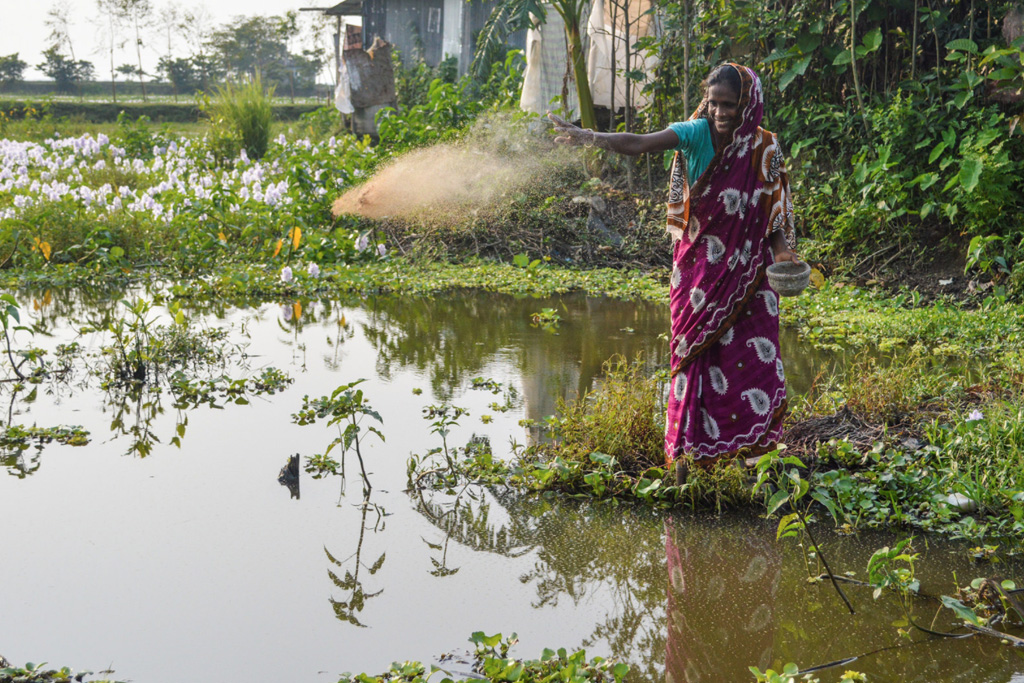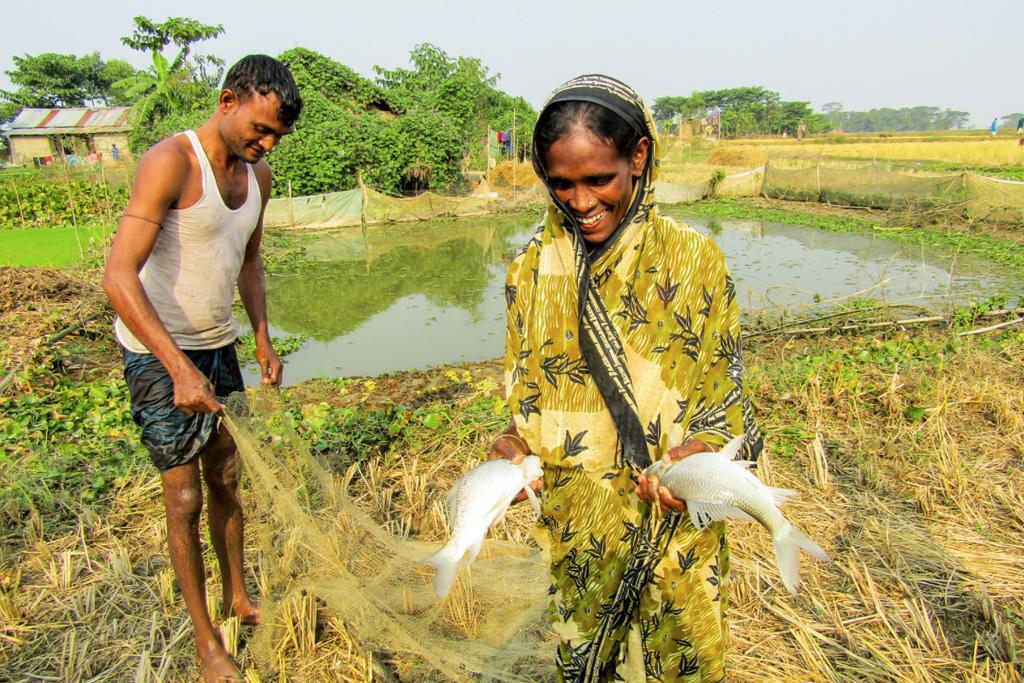-

Homegrown fish and vegetables:
A solution to combat
undernutrition in Bangladesh
Poor households in Sylhet division are being trained and supported to grow fish and vegetables on their homesteads, which is helping to combat widespread undernutrition by boosting consumption of nutritious food and increasing household income.
In Sylhet in northeastern Bangladesh, a division of nearly 10 million people, rates of undernutrition are among the highest in the country and the world. Almost 50 percent of children under five years of age are stunted—a form of chronic undernutrition—and the under-five mortality rate is 67 per 1000 children.
A contributing factor is that 68 percent of Sylhet’s population live below the international poverty line of USD 1.25 a day and have little or no land on which to grow food.
Despite the local availability of nutritious food, it is not affordable to the poorest households, and there is little homestead vegetable, fish or poultry production. This results in many households having diets that are low in diversity and rely heavily on the staple food, rice, contributing to the slow onset of an entrenched nutritional crisis.
To combat chronic undernutrition in Sylhet, particularly in the first 1000 days of life, the Suchana: Ending the cycle of undernutrition in Bangladesh program (2016–2022) is implementing a range of nutrition-sensitive, market-based and gender-sensitive activities.
Funded by DFID and the European Union, the program is being implemented by a Save the Children International-led consortium that includes WorldFish, Helen Keller International, International Development Enterprises and the International Centre for Diarrhoeal Disease Research, Bangladesh. This is in association with local NGOs Center for Natural Resource Studies, Friends in Village Development Bangladesh and RDRS.
Boosting local fish production and consumption
One of Suchana’s key program interventions is to help communities grow fish and vegetables around their homes.
Fish, particularly small fish when eaten whole, are an excellent source of micronutrients such as iron, zinc, calcium, vitamin A and vitamin B12, as well as fatty acids and animal protein. When affordable and available, the consumption of fish can alleviate nutritional deficiencies—a contributor to undernutrition in Sylhet—and are a key component in a balanced and nutritious diet.
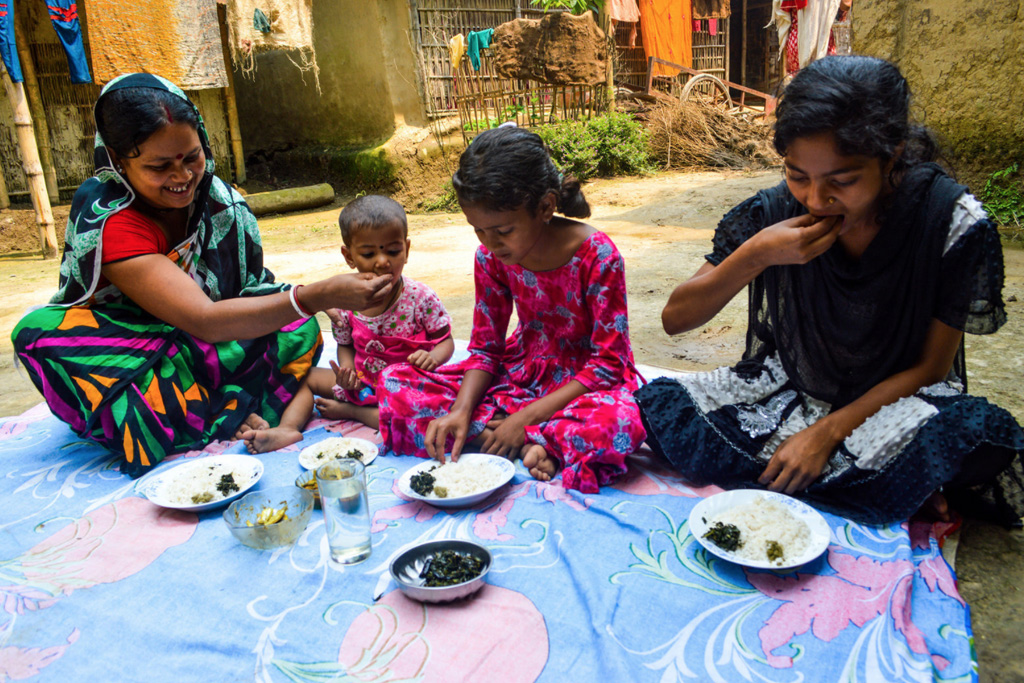
Pronoti Rani and her children are eating nutrition rich small fish in their meal in Moulavibazar, Bangladesh.
This intervention is being led by WorldFish, which is providing training in nutrition-sensitive aquaculture and horticulture production to poor and very poor, nutritionally-insecure females, including lactating and pregnant women and adolescent girls.
The training covers fish and vegetable farming technologies, and the importance of good nutrition. In addition, beneficiaries receive fingerlings and vegetable seeds.
“Now I am confident that I can farm enough fish and vegetables for my family to ensure the healthy growth of my children.” – Mala Begum, mother of three
Since the start of the project in 2016, 6610 women have received the training and 5109 households have received fingerlings of five large fish species: tilapia, rui, catla, mrigel and silver carp. By 2022, the project aims to have trained around 75,000 women on fish farming and horticulture and another 50,000 women on horticulture.
Fahima’s story: ‘We eat fish regularly’
The two-day training is a huge help to poor people who have very little land to farm on like Fahima Begum, a farmer and mother-of-two from Dithpur village.
From the training, Fahima learned how to produce nutrient-rich small fish such as mola in her homestead pond alongside carp and tilapia. Mola is a small indigenous species (SIS) that is found in most ponds and through better low-cost managaement practices can grow and multiply easily. Mola can be harvested partially often, making it ideal for regular household consumption.
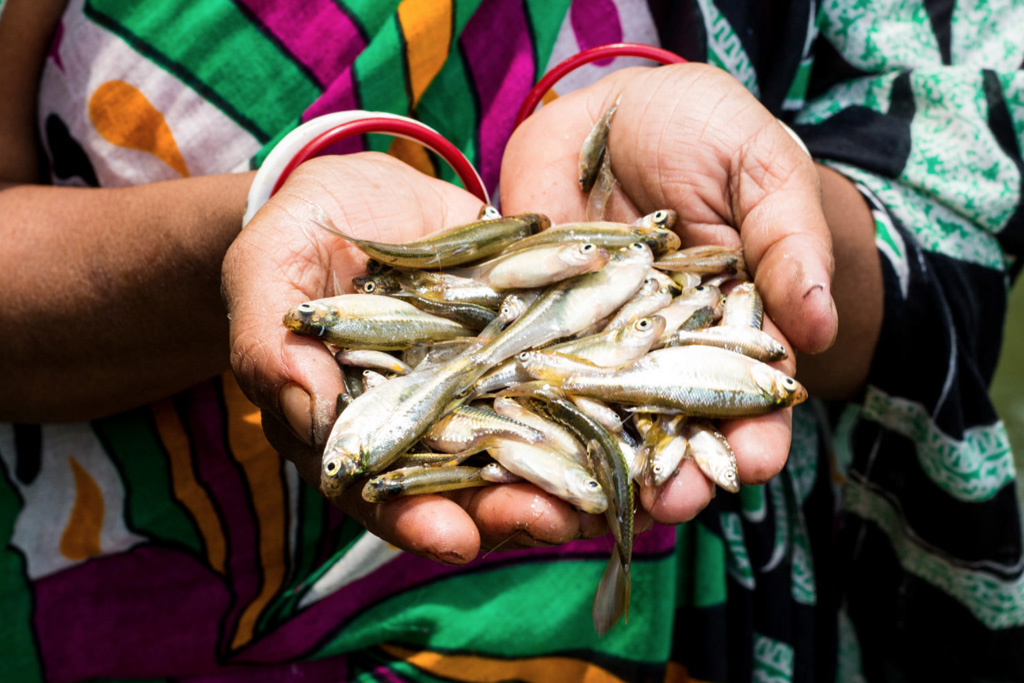
Pronoti Rani is showing Mola and other freshly harvested small fishes from her pond in Moulavibazar, Bangladesh.
After putting into practice the knowledge she had learned, Fahima and her husband Askir harvested 105 kg of fish from their 280 m2 (7 decimal) pond and 250 kg of vegetables from their homestead plot in 2016–17. This was a significant increase on their harvests in 2015–16, when they produced 12 kg of fish and 80 kg of vegetables.
Through the training, Fahima also learned how to clean and cook mola to ensure that the nutrients are not lost. The head is kept intact and for feeding young children the whole cooked mola is ground and added to rice and vegetables to make a nutritious meal.
“We eat fish regularly and provide smashed mola and other small fish to our children with their daily meal so that our nutritional needs can be fulfilled,” she said.
“The small fish we grow in our household pond is full of vitamin A and other micronutrients and will help our children to get proper nutrition in their crucial growing stages. We learned this from the Suchana project.”
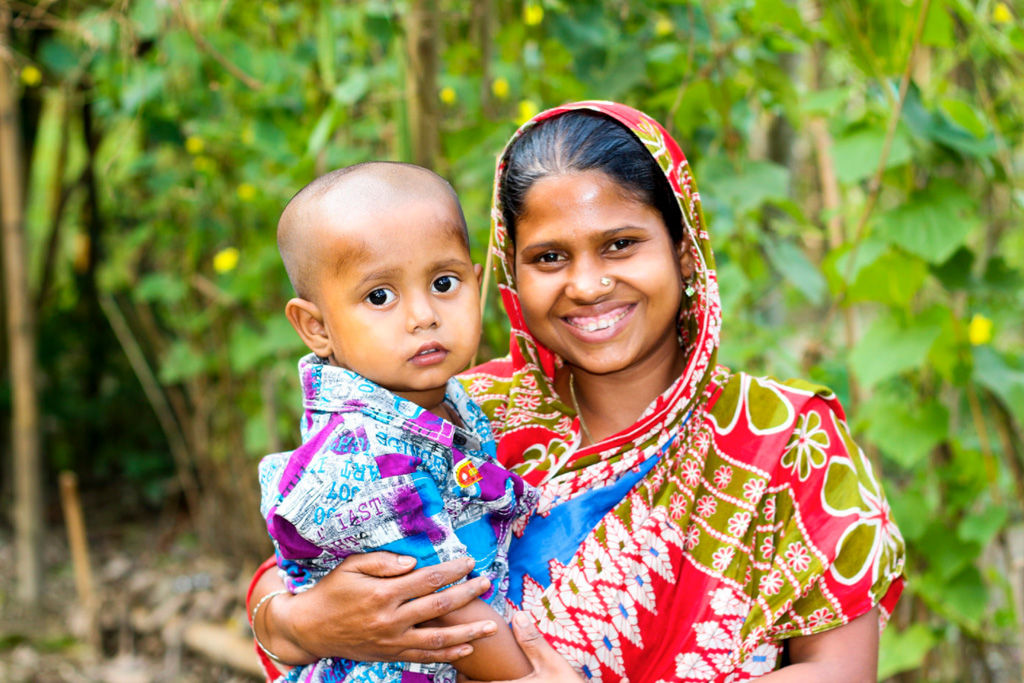
Fahima Begum and her 2 year old son in Sylhet, Bangladesh.
Mala’s story: A bumper harvest from a small pond
Similar successes were experienced by Mala Begum from Natun Sunampur village in Balaganj.
Mala and her husband Jalal once struggled to provide three meals a day for themselves and their three sons. Jalal’s income from working as a day labourer was insufficient to fully cover their food costs and homestead farming was difficult due to living in a flood-prone area.
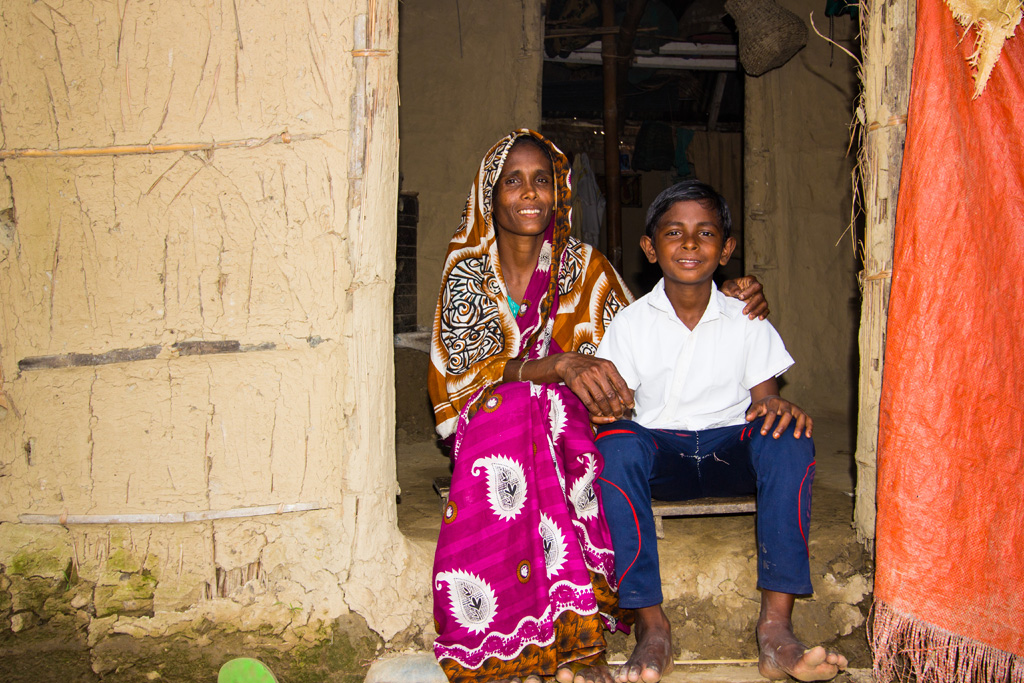
Mala Begum and her son in Sylhet, Bangladesh.
In August 2016, after attending the training, Mala and her husband started using the improved techniques to farm fish in their small 162 m2 (4 decimal) pond and grow vegetables in the 60 m2 (1.5 decimal) homestead in their house.
Just seven months later, they had a bumper harvest of 46 kg of fish (tilapia, rui, catla, mrigel, silver carp and small indigenous fish species (SIS)), 65 kg of beans, 32 kg of sweet gourd, 6 kg of red amaranth and 10 kg of orange sweet potato (OSP). This was despite some of their crops being damaged by heavy rainfall and flash floods, a common occurrence in Sylhet.
“I still can’t believe that I produced over 40 kg of fish from this small pond,” said Mala. “Now I am confident that I can farm enough fish and vegetables for my family to ensure the healthy growth of my children.”
After household consumption, Mala sold the surplus fish and vegetables and earned BDT 3015 (USD 37) and BDT 1250 (USD 15), respectively. She plans to use this money to expand her farming and income-generating activities.
These early success stories show how homestead fish and vegetable farming can boost consumption of nutritious foods and increase income at the household level—factors critical to enhancing nutritional outcomes. This will contribute to realizing Suchana’s end goal of reducing stunting in children under two years of age from 250,000 poor households in Sylhet.
Project
Suchana: Ending the cycle of undernutrition in BangladeshDonor:
United Kingdom Department for International Development, European UnionPartners:
Save the Children International, Helen Keller International, International Development Enterprises, the International Centre for Diarrhoeal Disease Research, BangladeshRelated sustainable development goals


Tags
Bangladesh, Asia, nutrition, livelihoods, food security, small-scale fisheries, molaImpacts
women trained in fish and vegetable technologies since August 2016
fish fingerlings distributed to poor households in Sylhet since August 2016
poor households in Sylhet have received fish fingerlings since August 2016
Related publications
Photo credits - WorldFish. Published on 28 September 2017.


